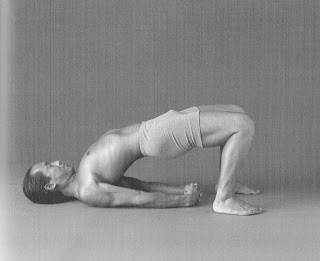by Baxter
 Bridge Pose |
I received this question a while back from one of our readers and thought today was the perfect day to address it:
“I often hear teachers instruct to come out of Bridge ‘one vertebra at a time.’ What are your thoughts on this? Is this healthier for the spine? Or is it in fact better to maintain the lower lumbar curve?”
It turns out that most of my first teachers would encourage just such an action when instruction for Bridge pose (Setu Bandha) with bent knees. In those days, I was practicing a style of yoga in which we would hold the poses for several minutes once in the shape of the pose. My instructors would often say to come up into Bridge one vertebrae at a time, as if your spine were taped to the floor and you were slowly peeling the tape off the floor. And they would suggest a similar action upon exiting the pose only in reverse: lower down slowly, one vertebra at a time, as if you were pressing the “tape” of the spine back onto the floor.
This way of entering or exiting Bridge pose is one of two basic ways I still think are valid and reasonable ways to work in the pose. The second way that I instruct entering and exiting is as follows: From Constructive Rest position (supine, knees bent and heels about 4 inches from your hips), establish the normal, slightly arched shape of your lumbar spine. Lift your hips straight up as you push down into your feet, like an elevator going up a few floors, maintaining the neutral arch of the lower back. To come down, lower your hips straight down, like an elevator returning to the lobby floor.
The obvious question would be what are the advantages to the two different ways of getting in and out of the pose? The Peel Method, as I call it, is particularly well suited to the generally stiff student who does not have any lower back problems, specifically, but not exclusively, lumbar disc issues. For the healthy, stiff student, this way of moving in and out of Bridge pose creates more movement in certain directions between the individual bones of the lower spine, a bit more flexion (forward bending) than extension. So you can create better movement in a stiff part of the body using the Peel Method. And it is a fine way to work with healthy students who have normal flexibility as well.
However, in my specialty Back Care class, where lots of students have bulging or inflamed discs or structures in the lower back, there may be some instability and/or too much mobility that can result in increased pain. In addition, flexion (such as in a forward folding, rounded spine) which as I mentioned above, happens with the Peel Method, could potentially worsen disc problems and even run-of-the-mill general lower back pain. So the Elevator Method provides more stability to the lower spine, as well as encouraging a more neutral or natural curve in the lumber spine. I find that almost all of my Back Care students can not only do this variation without pain, but also seem to benefit from the overall strengthening of the back body muscles that come form this particular back bend.
There will always be some students who are exceptions to the above recommendations, and so each individual has to try the methods out for themselves and see which feels better for their body and seems to have the overall desired effects from regular practice. And, as with all asana, there are certainly other creative ways to get in and out of Bridge, so playing around to find a new way of working in the pose can add some fun to your home practice as well. I personally like to mix up the way I enter and exit poses a bit, so that I don’t get stuck in a rut of doing things the same way each time. This way of varying things keeps my attention more clearly focused on the task at hand, so I am more present with my regular asana practice. And this cultivation of moment-by-moment awareness in my yoga practice has great benefit for my everyday activities as well. In this way, I can move beyond the mere performance of yoga poses and reap the deeper benefits that yoga has to offer. So, play around with Bridge pose this week and see what you discover for yourself.
Follow Yoga for Healthy Aging on Facebook ° To order Yoga for Healthy Aging: A Guide to Lifelong Well-Being, go to Amazon, Shambhala, Indie Bound or your local bookstore.


Is the Peel Method (flexion) also contraindicated for students with spinal osteoporosis?
if the main concern is for students w low back issues, props would help, under the shoulders and buttocks, this minimizes the distance the pelvis has to travel, also will minimize flexion in the neck, which may have issues also..you still can attain the chest opening effect of the pose which is of import….now you still have to be mindful of how to move in and out of pose.
I don't have back issue but i prefer to maintain normal lumbar curve in coming out….
As someone w/longstanding low back pain and a yoga practice extending back about 30 years, I learned the "elevator" method of bridging from my physical therapist, and find it much better for me–less chance of irritating or injuring myself and also strengthening areas that needed it for better support.